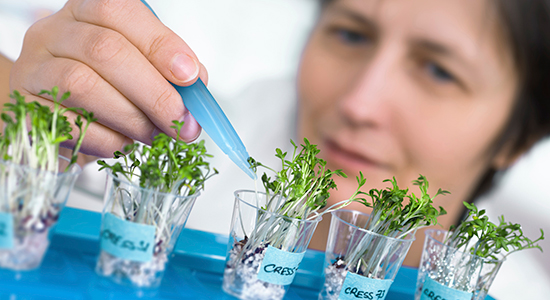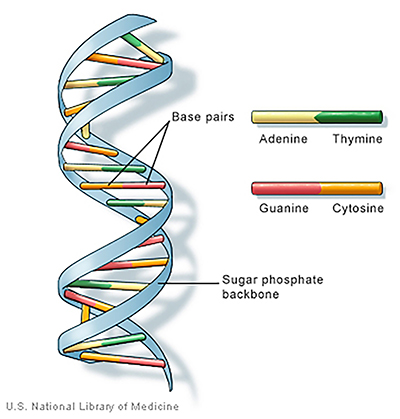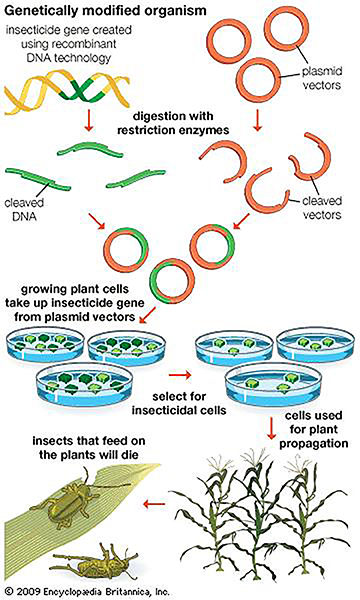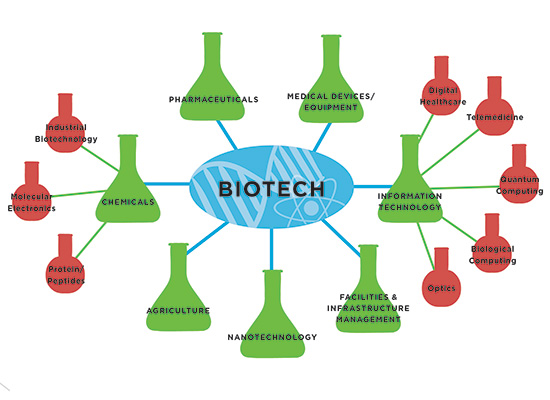
This article discusses the basic science behind modern biotechnology – what are the molecules and processes involved – and provides examples of the types of products that have been developed. Law and biotechnology intersect on many levels, but particularly in the venues of intellectual property (patents and licensing) and governmental regulations (both domestic and international). Understanding and appreciating the basic science behind biotechnology can increase lawyers’ impact and effectiveness in product and business development in the biotechnology industry. The article also discusses the role of biotechnology in DNA analysis for forensic applications, as an additional example of biotechnology intersecting with criminal prosecution.
What is Biotechnology?
Biotechnology is the use of intact living organisms, or components of living systems, for practical applications that enhance the quality of life for humans, other animals, or the environment. Humans have been performing biotechnology for more than 10,000 years, with the selective breeding of plants and animals, and the fermentation of various foods such as beer, wine, bread, yogurt, and cheese. Modern biotechnology focuses on providing products that treat, detect, or prevent human and other animal diseases, enhance food production, provide renewable energy, increase the efficiency of manufacturing processes, or provide the necessary tools for basic life science research.
The current field of biotechnology has had tremendous global impact, including through the development of:
250 biotechnology vaccines and treatments
More than 50 biorefineries in the United States alone for biofuel and biochemical production
Genetically modified crops (GMO), used by 18 million farmers, to increase yield, prevent damage from insects, and reduce environmental effects.1
What are DNA, RNA, and Proteins?
Cells are the basic building blocks of living organisms. DNA, RNA, and proteins are some of the most important biomolecules that make up all living cells, from simple bacteria to more complex human or animal cells. DNA (deoxyribonucleic acid) is the genetic material and blueprint for life. DNA has a very special chemical structure – nucleotide bases (abbreviated A, C, G, and T) are linked to a sugar-phosphate backbone, like rungs on a spiral staircase (see Figure 1). The order of the bases in the DNA is called its “sequence.” For example, a specific sequence would look like this: AGTCTGGTATAGATCTGTAT. All of the cells within a particular organism contain exactly the same DNA. The unique structure of DNA allows it to be copied when cells multiply (replication), but can also act as the template for passing along the necessary information for making proteins (transcription and translation. The genetic information needed to produce one protein is called a gene, and for humans, the total number of genes in a cell is estimated to be 20,000 – 25,000.2
Proteins provide all of the structural components to the cell and perform all of the necessary functions – energy production, metabolism, transport, and communication, to name a few. Proteins, composed of strings of amino acids, basically do all of the “work” in a cell. DNA supplies the “genotype” of a cell, while the proteins impart the “phenotype.”
The intermediary in this process is RNA (ribonucleic acid), and this information transfer – DNA to RNA to proteins – is referred to as the Central Dogma of Molecular Biology. DNA can be thought of as the computer program in the cell, while RNA is the computer language that is converted into the hardware proteins.
The amount of RNA, and thus proteins, present in any particular cell at any given time is highly regulated, and is controlled by signals both inside the cell (intracellular) and outside it (extracellular). These extracellular signals can include environmental and lifestyle factors such as hormones, diet, physical activity, medications, and pollutant exposure.
Figure 1
Chemical Structure of DNA

What Role Do Biomolecules Play in Biotechnology?
Both DNA and proteins play key roles in biotechnology. Many applications of biotechnology require the production of a particular protein, either to be used on its own (such as industrial enzymes) or in a living cell to alter the functions or capabilities (for example, a modified plant that is resistant to a particular insect or a bacteria being engineered to express a human protein – like insulin).
The ability to do this starts with the DNA, since it contains the information needed to produce the protein. Thus biotechnology is often associated with the genetic manipulation of an organism – adding new DNA or removing or modifying the existing DNA. This manipulation is accomplished using molecular biology tools that can modify DNA and insert it into the organism of choice – this process is referred to as recombinant DNA or genetic transformation.
Figure 2 exemplifies an overview of the genetic modification of a corn plant with a gene conferring resistance to a particular insect predator. The gene of interest (the insecticidal gene) is cut and joined to a special small circular molecule of DNA, called a plasmid, which can then be transferred into the experimental organism. Cells containing the new DNA are selected, ultimately producing an insect-resistant corn plant.
Figure 2
General Overview of DNA Modifications and the Creation of Genetically Modified Organisms

What Types of Biotechnology Products are Being Produced?
The diversity and breadth of products being produced by biotechnology is quite impressive, and the impact on society is staggering (see Figure 3).
Improvements in disease detection – through advanced diagnostic tests sensitive enough to accurately detect changes in DNA or proteins – have revolutionized modern medicine and health care, leading the way to more personalized treatments that are tailored to a person’s specific genotype. The search for new and better biomarkers that could be used in testing is a very active area of biotechnology, as is the development of new technologies for the detection of such disease-related biomarkers.
More potent and specific treatments for a wide variety of diseases, particularly cancer, have been developed. These “biotherapeutics” consist of hormones (like insulin), small proteins called peptides that can control cell signaling, or larger proteins such as antibodies that can interact very specifically with cells or other molecules to affect how a diseased cell functions. Antibodies in particular, which are a normal component of the immune system, can be manipulated and harnessed to treat diseases such as cancer, rheumatoid arthritis, inflammatory bowel disease, psoriasis, asthma, and osteoporosis. Seven of the top 10 best-selling global drugs are actually biotechnology-developed protein therapies.3
Figure 3
Overview of the Biotechnology Industry and the Diverse Fields it Impacts

Vaccines were one of the first biotechnology treatments ever developed, and currently there are approximately 30 commercially available vaccines addressing a wide variety of infectious bacteria or viruses, including polio, measles, influenza, pneumonia, meningitis, and hepatitis. More than 20 vaccines are in development to address other infectious agents, such as HIV, malaria, herpes, Chagas disease, salmonella, and hookworm.4 Many biotechnology companies are also developing vaccines to target cancer, either to prevent or treat the disease.5
By genetically manipulating plants, bacteria, yeast, and algae, the production of renewable biofuels, bioplastics, and chemicals is a reality. In addition, using engineered bacteria to remove hazardous waste from the environment is also having an impact on reducing humanity’s negative global footprint.
With the growing global population, the availability of sufficient nutritionally complete food to all areas of the world will require diverse and creative solutions that neither harm the environment nor deplete natural resources like clean water. Biotechnology is focusing on traits and crops that can address these problems (see Table 1).
Many industrial processes – including paper and textile production, detergents, food production, and bioenergy – require the use of very large quantities of proteins, called enzymes, that can perform a specific chemical reaction to create defined products. Biotechnology allows for the improvement on or creation of new enzymes to increase the efficiency of many manufacturing processes, resulting in lower cost for consumers or the availability of new products.
Improved tools for basic life science research have fueled the discovery of countless innovations that will lead to improved human, animal, and environmental health. Technologies that allow for the purification, detection, and manufacture of different biomolecules, particularly DNA and proteins, are constantly being added to the repertoire of the techniques scientists can use in discovery. Technologies that allow for the sequencing of DNA to be determined efficiently and cost effectively have led to advancements in diagnostic testing, environmental monitoring, and the analysis of all the microbes that live on and in the human body and our environment. These “Next Generation Sequencing” technologies have brought personalized medicine and the sequencing of each human’s genome one step closer.6
Table 1
Current Trait Modifications and Crops Generated Through Biotechnology
| Traits Being Modified/Affected |
Crops Being Modified |
- Increased yield
- Disease resistance
- Nitrogen fixation
- Drought and stress tolerance
- Increased nutritional value
- Herbicide resistance
- Pesticide resistance
- Reduced use of pesticides
|
- Corn
- Soy
- Canola/rapeseed
- Sugar beet
- Sugarcane
- Papaya
- Squash
- Rice
- Tomato
- Potato
- Apple
- Sweet pepper
|
How is Biotechnology Involved in Forensic DNA Analysis?
The ability to detect and analyze DNA in such a way that it can be used as a unique identifier of individuals has led to its widespread use in the forensic community. The DNA markers identified, and the techniques used to detect and analyze them, were developed through efforts in biotechnology. Improving current technologies and developing new ones are also active research areas in biotechnology.
 Dr. Natalie Betz is associate director of the University of Wisconsin’s Master of Science in Biotechnology Program, designed for science or business working professionals who want to expand their expertise and impact in the field of biotechnology. The program covers the science, business, law, ethics, and regulation in biotechnology. She also designs and leads laboratory courses in biotechnology and molecular biology for the BioPharmaceutical Technology Center Institute, a nonprofit organization supported by Promega Corp. that delivers education outreach for K-12 students and adults.
Dr. Natalie Betz is associate director of the University of Wisconsin’s Master of Science in Biotechnology Program, designed for science or business working professionals who want to expand their expertise and impact in the field of biotechnology. The program covers the science, business, law, ethics, and regulation in biotechnology. She also designs and leads laboratory courses in biotechnology and molecular biology for the BioPharmaceutical Technology Center Institute, a nonprofit organization supported by Promega Corp. that delivers education outreach for K-12 students and adults.
Currently, the most commonly used DNA-identifying technique is STR (short tandem repeat) analysis, coupled with the PCR (polymerase chain reaction – a method to copy DNA), in which several regions of short repeated sequences are analyzed so that the pattern of these repeated sequences is unique in each person, with the exception of identical twins; these sequences repeat a variable number of times in different individuals. The likelihood of two individuals having the same pattern at multiple regions (or loci) is exceedingly unlikely, and supports the statistical power of using this technique to uniquely match a DNA sample with a particular individual.7 The total random-match probability is the probability of the exact genetic profile being found in someone within the human population, other than the suspect.8 The use of these variable STR regions has been invaluable at distinguishing individuals based on DNA, as 99.99 percent of the DNA between different humans is the same – these STR regions are part of the 0.01 percent difference.
DNA can be obtained from almost any biological sample, including fingerprint evidence, and the STR technique requires very little DNA to be successful. Thus a crime scene sample can be matched to an individual with a high degree of accuracy if a DNA profile from that individual is available. DNA evidence can also be used to solve cold cases or extend the statute of limitation on a particular crime by issuing a John Doe DNA warrant and charging an individual’s DNA profile. Recent changes to many state laws have removed the need to issue the John Doe DNA warrant if DNA evidence is available. In addition, DNA evidence can be used to exonerate convicted individuals.9
As long as the evidence is properly collected and handled, DNA evidence is highly accurate. Because of this, it is often relied on to prove innocence or guilt, or at least who was at a particular crime scene. However, the accuracy of the DNA results is only as good as the accuracy and care taken during sample collection and processing, both before and at the forensic laboratory. The sensitivity of the technology used to analyze the DNA also makes contamination with other DNA or biological samples an issue. It is time consuming and complex to collect and analyze DNA evidence, and this can be frustrating for law enforcement officials, prosecutors, and victims.
Current trends in the field include improving and expanding the databases used to store DNA profiles of convicted felons (such as the FBI’s Combined DNA Index System – CODIS), and for some states, arrestees as well. In the future, it may become much more common to search familial DNA to identify suspects who are not in the database, but might have a relative in the database.
Conclusion
The basic building blocks of life are harnessed in biotechnology to impact diverse areas, including health, energy, agriculture, industrial processes, basic life science research tools, and forensics. All of these applications are driven by the intellectual property context and the governmental regulations that exist. It is exciting to contemplate what biotechnology will bring in the future and how it will continue to affect society. The role of the law in biotechnology will only continue to increase as the science and business landscapes become more and more complex.
Endnotes
1 Biotechnology Innovation Organization. All figures in this article used with permission.
2 National Institute of Health’s Genetic Home Reference.
3 Top101News.
4 World Health Organization.
5 National Cancer Institute.
6 E.L. Van Dijk et al. (2014), Ten Years of Next-generation Sequencing Technology, Trends in Genetics 30(9): 418-26.
7 National Institute of Justice. FindLaw.
8 L.R. Kreeger (2003), Forensic DNA Fundamentals for the Prosecutor, Be Not Afraid, DNA Forensics Program, American Prosecutors Research Institute.
9 The National Center for Victims of Crime, Profiles in DNA, Interview with Norman Gahn, Assistant District Attorney for Milwaukee County, Wis.
